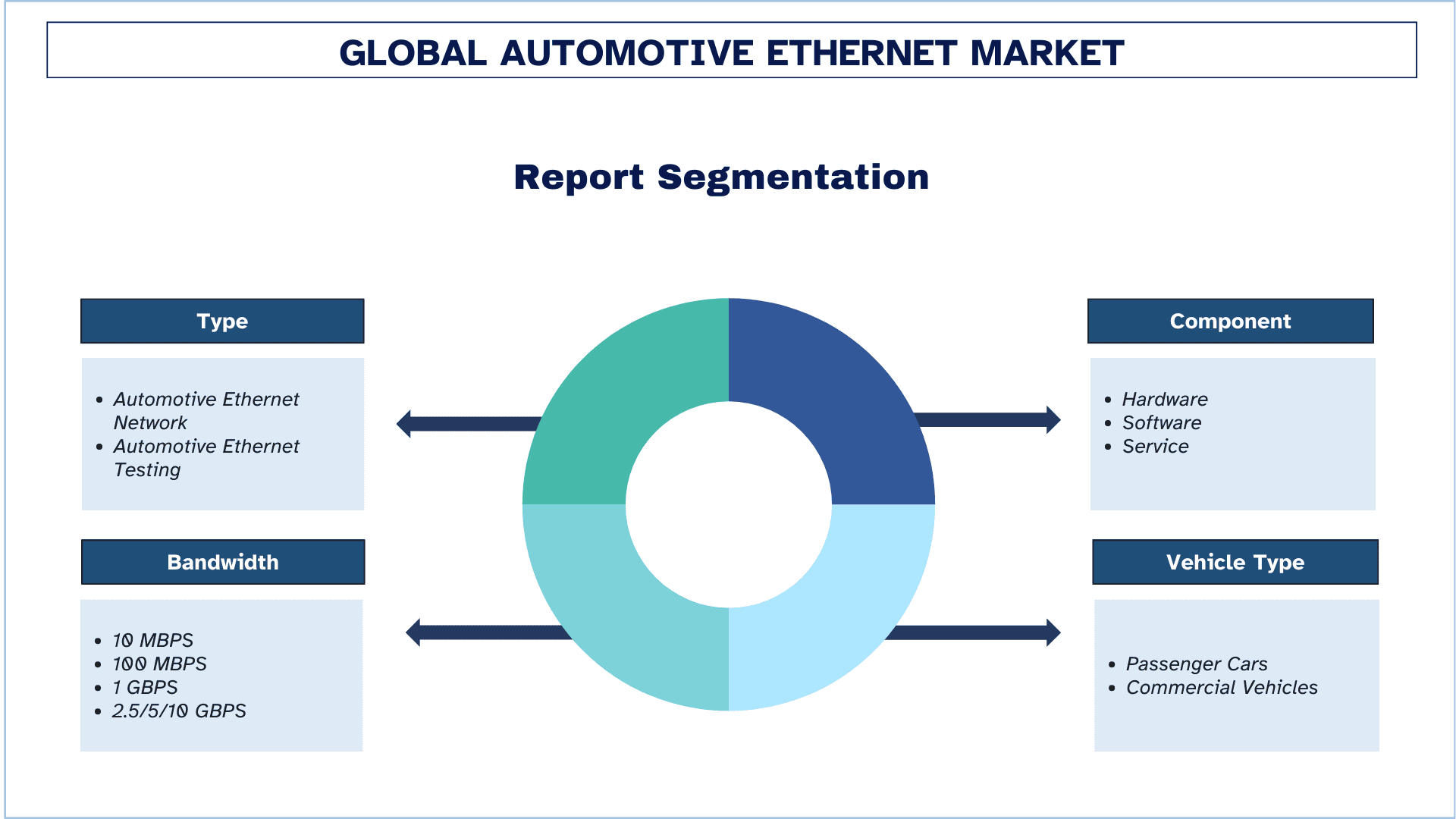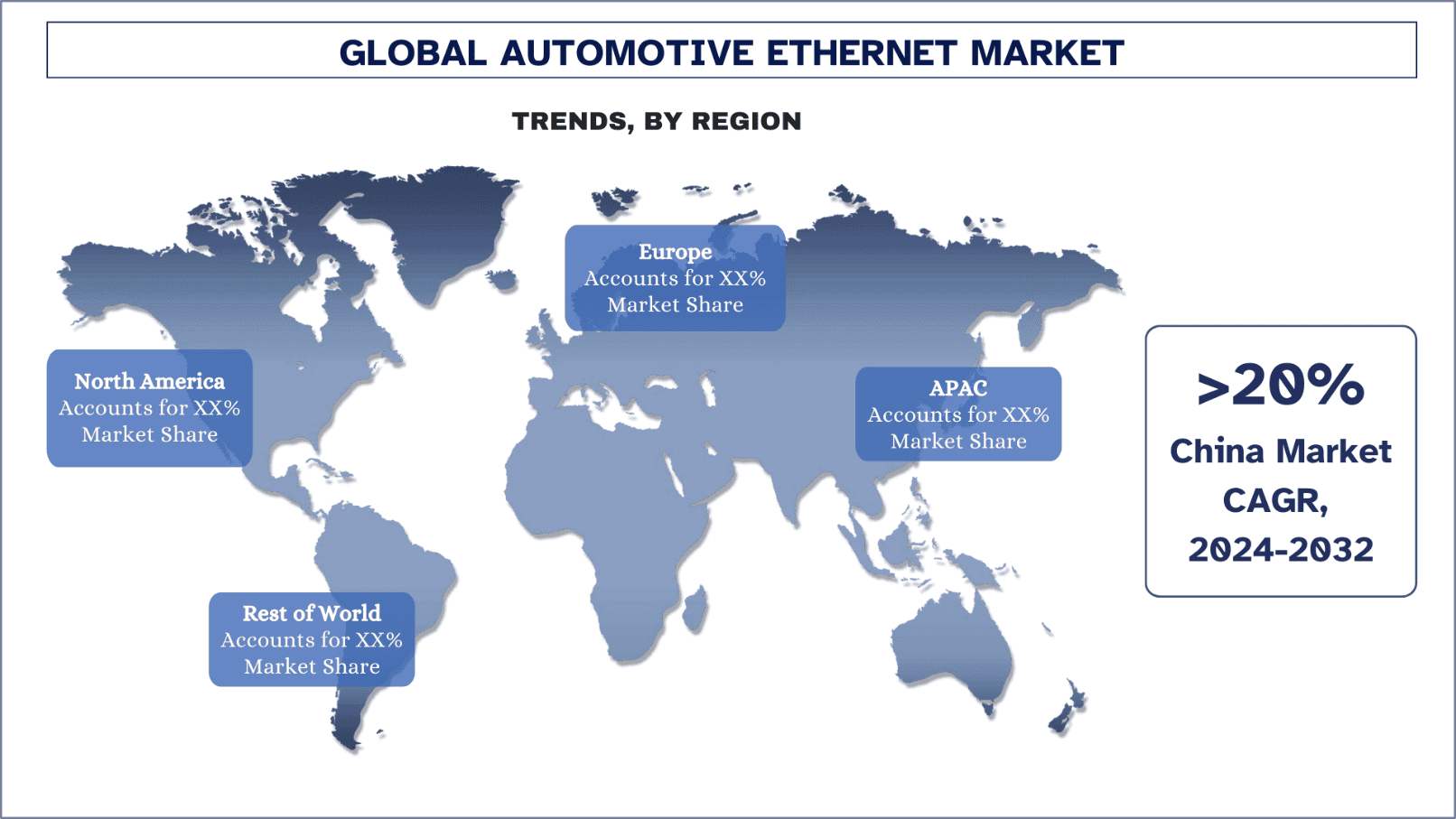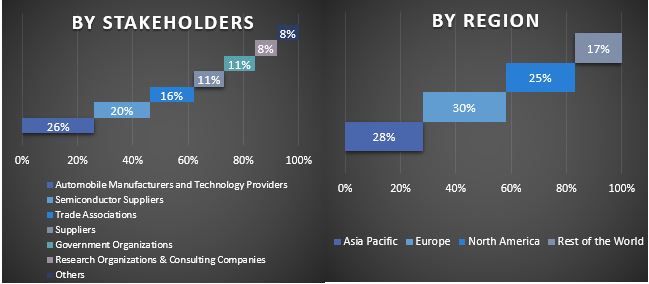
汽车以太网市场规模与预测
2023年汽车以太网市场价值为25.0127亿美元,预计在预测期内(2024-2032年)将以约19.0%的强劲复合年增长率增长,这得益于乘用车和商用车对ADAS功能日益增长的需求、对高数据带宽和更快的连接的需求不断增长,以及对信息娱乐系统和其他功能的需求。
汽车以太网市场分析
在预测期内,汽车以太网市场正在以19.0%的强劲增长率增长。消费者对复杂的车载连接技术和数据传输系统需求的增加推动了行业扩张。汽车以太网充当一个关键的基础设施要素,将各种高级驾驶员辅助系统(ADAS)与信息娱乐应用和自动驾驶组件及技术联系起来。汽车电子行业现在面临对可靠的高速可扩展网络解决方案的迫切需求,因为互联汽车和复杂的汽车组件持续呈指数级增长。此外,现代汽车受益于汽车以太网,它提供了广泛的带宽以及最小的延迟和轻量级的功能,这些功能超越了传统的网络技术,从而扩大了市场增长。由于越来越多的车辆现在连接到云系统,并且软件更新通过空中(OTA)技术自动应用,市场经历了额外的增长。此外,以太网技术的集成超出了高端车辆的范围,因为消费者需求的增长要求其出现在高端和中端车辆中。
汽车以太网市场趋势
专注于高速、低延迟网络
互联和自动驾驶汽车(CAV)之间日益复杂的局面需要先进的低延迟、高带宽网络解决方案。现在,汽车以太网充当传统网络的主要通信标准,因为它提供比CAN LIN和FlexRay方法更快的数据速度和更可靠的系统性能。实时数据同步是自动驾驶汽车和人工智能系统的一个基本必要条件,而时间敏感网络(TSN)通过其范围保证了这一点。互联汽车技术的日益普及以及远程车辆诊断产生了增强的网络安全挑战。汽车行业将人工智能安全功能整合到汽车以太网中,以提供即时入侵检测以及自动网络异常识别。例如,2024年,AVIVA Links Inc 推出了其首批基于汽车SerDes联盟运动链路以太网(ASA-MLE)的多千兆位以太网设备,以推进用于人工智能和ADAS系统的车辆基础设施。AVIVA Links发布了以太网PHY和交换机以及分区聚合器和CSI-2桥接IC,这些都满足了高带宽非对称汽车链路系统的特定要求。这些设备充当基本基础设施的内聚元素,以创建下一代智能软件定义汽车(SDV)。

亚太地区主导汽车以太网市场
预计亚太地区汽车以太网市场将在预测期内占据主导地位。促成市场增长的主要因素包括强大的汽车制造基地、电动汽车的更高采用率、对连接和信息娱乐系统日益增长的需求以及对高级驾驶员辅助系统(ADAS)日益增长的需求。亚太地区正在快速采用高级驾驶员辅助系统(ADAS)以及自动驾驶汽车(AV)和电动汽车(EV)。汽车以太网证明适合管理高级汽车系统的大量数据需求,尽管它们需要快速且可靠的通信网络基础设施。例如,2024年12月,本田推出了Amaze车型,通过其在印度的顶级ZX装饰发布,配备了ADAS功能。中国、日本、印度和韩国等国家共同构成了亚太地区的主要汽车制造区域。这些国家将成熟的、已建立的汽车制造商与专注于电动和自动驾驶汽车创新的新兴汽车公司结合起来。该地区的汽车制造活动为以太网技术在车辆数据连接和传输需求方面的应用提供了动力。包括中国和日本在内的国家正在引领电动汽车的实施,因为各种制造公司都在提高其电动汽车产量。中国和韩国在自动驾驶技术领域的发展速度方面处于世界领先地位。支持这些汽车对高带宽网络的需求不断增长,为汽车以太网技术创造了巨大的需求。

汽车以太网市场概述
汽车以太网市场竞争激烈且集中,只有少数全球和国际参与者。主要参与者正在采取不同的增长战略来增强其市场地位,例如合作、协议、协作、新产品发布、地域扩张以及兼并和收购。一些主要的市场参与者包括博通、Marvell、恩智浦半导体、德州仪器公司、铿腾电子科技公司、是德科技、瑞昱半导体公司、罗德与施瓦茨、思博伦通信和亚德诺半导体公司。
汽车以太网市场新闻
2022年3月,Marvell推出了其第三代Marvell® Brightlane™以太网交换机,标志着业界最安全的托管汽车交换机,具有用于高可靠性关键任务汽车安全应用的锁步双核Arm处理冗余功能。
2023年7月,Microchip Technology将其首款汽车级以太网PHY推向市场。来自同一系列的这些10BASE-T1S设备获得了AEC-Q100 Grade 1认证,作为LAN8670/1/2产品系列的一部分。LAN8670/1/2 10BASE-T1S以太网PHY作为功能安全解决方案运行,准备好支持根据ISO 26262安全标准实施的应用。将10BASE-T1S设备集成到标准以太网系统中,使制造商能够将先前独立的低速通信系统连接到在汽车应用中单个标准化的网络上运行。
2022年9月,KPIT Technologies通过一项价值8220万美元(8000万欧元)的交易收购了Technica Engineering旗下的四家子公司。通过此次收购,KPIT本身将为客户提供完整的汽车以太网解决方案。总部位于德国的汽车以太网解决方案制造商Technica Engineering的所有子公司都来自Technica Engineering Gmbh,德国,Technica Electronics Barcelona S.L.在西班牙与Technica Engineering Spain S.L.合并,也在西班牙。
2023年11月,博通以610亿美元的价格收购了VMware, Inc.,并于2023年11月完成了最后阶段。通过此次收购,博通将加速创新,从而实现扩展的应用设计选项,同时为大规模运营控制和保护提供增强的灵活性。
汽车以太网市场报告范围
报告属性e | 详情 |
基准年 | 2023 |
预测期 | 2024-2032 |
增长势头 | 以19.0%的复合年增长率加速 |
2023年市场规模 | 25.0127亿美元 |
区域分析 | 北美、欧洲、亚太地区、世界其他地区 |
主要贡献区域 | 2023年亚太地区主导市场 |
涵盖的主要国家 | 美国、加拿大、德国、英国、西班牙、意大利、法国、中国、日本和印度 |
公司概况 | 博通、Marvell、恩智浦半导体、德州仪器公司、铿腾电子科技公司、是德科技、瑞昱半导体公司、罗德与施瓦茨、思博伦通信和亚德诺半导体公司 |
报告范围 | 市场趋势、驱动因素和限制因素;收入估算和预测;细分市场分析;供需方分析;竞争格局;公司概况 |
购买本报告的理由:
该研究包括经过验证的、由权威的行业专家验证的市场规模和预测分析。
该报告快速概览了整个行业的业绩。
该报告涵盖了对主要行业同行的深入分析,重点关注关键的业务财务、产品组合、扩张战略和近期发展。
对行业中普遍存在的驱动因素、限制因素、关键趋势和机遇的详细考察。
该研究全面涵盖了不同细分市场的市场。
深入分析行业的区域层面。
自定义选项:
全球汽车以太网市场可以根据需求或任何其他细分市场进行进一步定制。除此之外,UMI了解到您可能拥有自己的业务需求,因此请随时与我们联系以获取完全符合您要求的报告。
目录
汽车以太网市场分析研究方法 (2024-2032)
分析历史市场,估算当前市场,并预测全球汽车以太网市场的未来市场,是创建和分析汽车以太网在全球主要区域采用情况的三个主要步骤。进行了详尽的二手研究,以收集历史市场数据并估算当前市场规模。其次,为了验证这些见解,考虑了许多发现和假设。此外,还与全球汽车以太网市场价值链中的行业专家进行了详尽的一手访谈。在通过一手访谈对市场数据进行假设和验证后,我们采用了自上而下/自下而上的方法来预测完整的市场规模。此后,采用了市场细分和数据三角剖分方法来估算和分析与行业相关的细分市场和子细分市场的市场规模。详细的方法如下:
历史市场规模分析
步骤 1:深入研究二手资料:
进行了详细的二手研究,通过公司内部来源(如年度报告和财务报表、业绩演示、新闻稿等)以及外部来源(包括期刊、新闻和文章、政府出版物、竞争对手出版物、行业报告、第三方数据库和其他可靠出版物)来获得汽车以太网的历史市场规模。
步骤 2:市场细分:
在获得汽车以太网市场的历史市场规模后,我们进行了详细的二手分析,以收集主要区域不同细分市场和子细分市场的历史市场洞察和份额。报告中包含的主要细分市场包括类型、组件、带宽、车辆类型和应用。进一步进行了国家层面的分析,以评估该区域测试模型的整体采用情况。
步骤 3:因素分析:
在获得不同细分市场和子细分市场的历史市场规模后,我们进行了详细的因素分析,以估算汽车以太网的当前市场规模。此外,我们使用自变量和因变量(如类型、组件、带宽、车辆类型和汽车以太网的应用)进行了因素分析。对考虑了顶级合作伙伴关系、并购、业务扩张以及全球汽车以太网市场领域的 产品发布 的供需情况进行了彻底的分析。
当前市场规模估算与预测
当前市场规模测算:基于上述 3 个步骤的可操作见解,我们得出了当前的市场规模、全球汽车以太网市场的主要参与者以及各细分市场的市场份额。所有必需的百分比份额拆分和市场细分均使用上述二手方法确定,并通过一手访谈进行验证。
估算与预测:对于市场估算和预测,为不同的因素(包括驱动因素和趋势、限制因素和利益相关者可用的机会)分配了权重。在分析了这些因素后,应用了相关的预测技术,即自上而下/自下而上的方法,以得出 2032 年全球主要市场不同细分市场和子细分市场的市场预测。用于估算市场规模的研究方法包括:
就收入(美元)而言,行业市场规模以及汽车以太网市场在主要国内市场的采用率
市场细分和子细分市场的所有百分比份额、拆分和细分
全球汽车以太网市场的主要参与者,提供 产品 。此外,这些参与者为在快速增长的市场中竞争而采取的增长战略。
市场规模和份额验证
一手研究:与主要区域的关键意见领袖 (KOL)(包括高层管理人员(CXO/VP、销售主管、市场营销主管、运营主管、区域主管、国家主管等))进行了深入访谈。然后对一手研究结果进行总结,并进行统计分析以证明既定假设。将一手研究的输入与二手发现相结合,从而将信息转化为可操作的见解。
不同区域的一手参与者分布
市场工程
采用数据三角剖分技术来完成整体市场估算,并得出全球汽车以太网市场每个细分市场和子细分市场的精确统计数字。在研究了类型、组件、带宽、车辆类型和应用领域中的各种参数和趋势后,将数据拆分为几个细分市场和子细分市场。
全球汽车以太网市场研究的主要目标
本研究查明了全球汽车以太网市场的当前和未来市场趋势。投资者可以获得战略见解,以根据研究中进行的定性和定量分析来决定其投资。当前和未来的市场趋势决定了市场在区域层面的整体吸引力,为行业参与者提供了利用未开发市场以从先发优势中获益的平台。研究的其他定量目标包括:
分析汽车以太网市场以价值(美元)衡量的当前和预测市场规模。此外,分析不同细分市场和子细分市场的当前预测和市场规模。
研究中的细分市场包括类型、组件、带宽、车辆类型和应用领域。
定义和分析汽车以太网的监管框架
分析涉及各种中介机构的价值链,以及分析行业的客户和竞争对手行为。
分析主要区域汽车以太网市场的当前和预测市场规模。
报告中研究的主要区域国家/地区包括亚太地区、欧洲、北美和世界其他地区
汽车以太网市场的公司概况以及市场参与者为在快速增长的市场中保持生存而采取的增长战略。
行业深度区域级分析。
常见问题 常见问题
问题1:汽车以太网市场的当前市场规模和增长潜力是什么?
汽车以太网市场在2023年的估值为25.0127亿美元,预计在预测期内(2024-2032年)将以19.0%的复合年增长率增长。
问题2:推动汽车以太网市场增长的因素是什么?
对改进的高速低延迟通信系统以及互联电动汽车和自动驾驶汽车的持续发展,极大地推动了市场发展。
问题3:按车辆类型划分,哪个细分市场拥有最大的汽车以太网市场份额?
乘用车细分市场按车辆类型划分拥有最大的汽车以太网市场份额。
问题4:汽车以太网市场的新兴技术和趋势是什么?
对高速和低延迟网络的关注是汽车以太网市场的重要趋势之一。
问题5:哪个地区将主导汽车以太网市场?
预计亚太地区将在预测期内主导市场。
相关 报告
购买此商品的客户也购买了











